清华大学:《分子生物学》课程PPT教学课件(基因ene)第十三章 DNA复制(DNA replication)
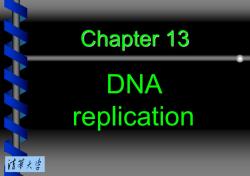
Chapter 13 DNA replication 清苇大当
Chapter 13 DNA replication
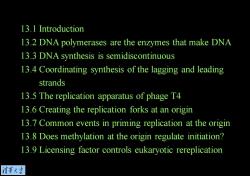
13.1 Introduction 13.2 DNA polymerases are the enzymes that make DNA 13.3 DNA synthesis is semidiscontinuous 13.4 Coordinating synthesis of the lagging and leading strands 13.5 The replication apparatus of phage T4 13.6 Creating the replication forks at an origin 13.7 Common events in priming replication at the origin 13.8 Does methylation at the origin regulate initiation? 13.9 Licensing factor controls eukaryotic rereplication 清菜大当
13.1 Introduction 13.2 DNA polymerases are the enzymes that make DNA 13.3 DNA synthesis is semidiscontinuous 13.4 Coordinating synthesis of the lagging and leading strands 13.5 The replication apparatus of phage T4 13.6 Creating the replication forks at an origin 13.7 Common events in priming replication at the origin 13.8 Does methylation at the origin regulate initiation? 13.9 Licensing factor controls eukaryotic rereplication
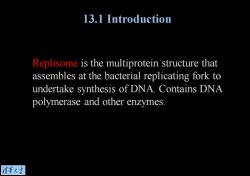
13.1 Introduction Replisome is the multiprotein structure that assembles at the bacterial replicating fork to undertake synthesis of DNA.Contains DNA polymerase and other enzymes 清苇大当
Replisome is the multiprotein structure that assembles at the bacterial replicating fork to undertake synthesis of DNA. Contains DNA polymerase and other enzymes. 13.1 Introduction
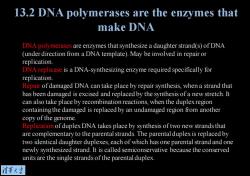
13.2 DNA polymerases are the enzymes that make DNA DNA polymerases are enzymes that synthesize a daughter strand(s)of DNA (under direction from a DNA template).May be involved in repair or replication. DNA replicase is a DNA-synthesizing enzyme required specifically for replication. Repair of damaged DNA can take place by repair synthesis,when a strand that has been damaged is excised and replaced by the synthesis of a new stretch.It can also take place by recombination reactions,when the duplexregion containing the damaged is replaced by an undamaged region from another copy of the genome. Replication of duplex DNA takes place by synthesis of two new strands that are complementary to the parental strands.The parental duplex is replaced by two identical daughter duplexes,each of which has one parental strand and one newly synthesized strand.It is called semiconservative because the conserved units are the single strands of the parental duplex. 情菜大学
DNA polymerases are enzymes that synthesize a daughter strand(s) of DNA (under direction from a DNA template). May be involved in repair or replication. DNA replicase is a DNA-synthesizing enzyme required specifically for replication. Repair of damaged DNA can take place by repair synthesis, when a strand that has been damaged is excised and replaced by the synthesis of a new stretch. It can also take place by recombination reactions, when the duplex region containing the damaged is replaced by an undamaged region from another copy of the genome. Replication of duplex DNA takes place by synthesis of two new strands that are complementary to the parental strands. The parental duplex is replaced by two identical daughter duplexes, each of which has one parental strand and one newly synthesized strand. It is called semiconservative because the conserved units are the single strands of the parental duplex. 13.2 DNA polymerases are the enzymes that make DNA
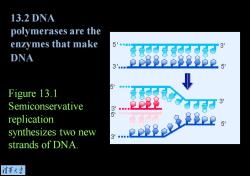
13.2 DNA polymerases are the enzymes that make 5'■ DNA 3' 都8PB88的2 5 Figure 13.1 Semiconservative 3 replication synthesizes two new strands of DNA 清菜大当
Figure 13.1 Semiconservative replication synthesizes two new strands of DNA. 13.2 DNA polymerases are the enzymes that make DNA
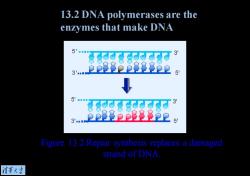
13.2 DNA polymerases are the enzymes that make DNA 5 3 3'l 8 Re8te088gee 5 Figure 13.2 Repair synthesis replaces a damaged strand of DNA 清菜大当
Figure 13.2 Repair synthesis replaces a damaged strand of DNA. 13.2 DNA polymerases are the enzymes that make DNA
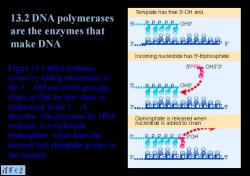
Template has free 3'-OH end 13.2 DNA polymerases 5.PP PP OH3 are the enzymes that make DNA 3'mn Incoming nucleotide has 5'-triphosphate Figure 13.3 DNA synthesis 5'PPR OH3'3' occurs by adding nucleotides to the 3 -OH end of the growing 5am.PPP2P、OH3 chain,so that the new chain is synthesized in the 5 -3 3'n 经P3经025 direction.The precursor for DNA Diphosphate is released when synthesis is a nucleoside nucleotide is added to chain triphosphate,which loses the 5P PPPP POH terminal two phosphate groups in the reaction. 3 清菜大当
Figure 13.3 DNA synthesis occurs by adding nucleotides to the 3 -OH end of the growing chain, so that the new chain is synthesized in the 5 -3 direction. The precursor for DNA synthesis is a nucleoside triphosphate, which loses the terminal two phosphate groups in the reaction. 13.2 DNA polymerases are the enzymes that make DNA
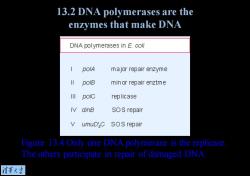
13.2 DNA polymerases are the enzymes that make DNA DNA polymerases in E.coli poiA ma jor repair enzyme poiB min or repair enztme 用 poiC rep licase IV dinB SOS repair umuD'C SOS repair Figure 13.4 Only one DNA polymerase is the replicase The others participate in repair of damaged DNA 清菜大当
Figure 13.4 Only one DNA polymerase is the replicase. The others participate in repair of damaged DNA. 13.2 DNA polymerases are the enzymes that make DNA
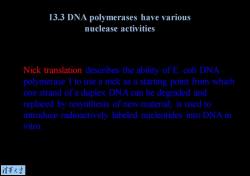
13.3 DNA polymerases have various nuclease activities Nick translation describes the ability of E.coli DNA polymerase I to use a nick as a starting point from which one strand of a duplex DNA can be degraded and replaced by resynthesis of new material: is used to labeled nucleotides into DNA vitro 清菜大当
Nick translation describes the ability of E. coli DNA polymerase I to use a nick as a starting point from which one strand of a duplex DNA can be degraded and replaced by resynthesis of new material; is used to introduce radioactively labeled nucleotides into DNA in vitro. 13.3 DNA polymerases have various nuclease activities
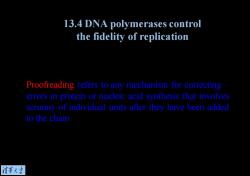
13.4 DNA polymerases control the fidelity of replication Proofreading refers to any mechanism for correcting errors in protein or nucleic acid synthesis that involves scrutiny of individual units after they have been added to the chain 清菜大当
Proofreading refers to any mechanism for correcting errors in protein or nucleic acid synthesis that involves scrutiny of individual units after they have been added to the chain. 13.4 DNA polymerases control the fidelity of replication
按次数下载不扣除下载券;
注册用户24小时内重复下载只扣除一次;
顺序:VIP每日次数-->可用次数-->下载券;
- 清华大学:《分子生物学》课程PPT教学课件(基因ene)第十二章 复制子(The replicon).ppt
- 清华大学:《分子生物学》课程PPT教学课件(基因ene)第十一章 噬菌体的战略(Phage strategies).ppt
- 清华大学:《分子生物学》课程PPT教学课件(基因ene)第十章 操纵子(The operon).ppt
- 清华大学:《分子生物学》课程PPT教学课件(基因ene)第九章 转录(Transcription).ppt
- 清华大学:《分子生物学》课程PPT教学课件(基因ene)第八章 蛋白质定位(Protein localization).ppt
- 清华大学:《分子生物学》课程PPT教学课件(基因ene)第七章 遗传密码的利用(Using the genetic code).ppt
- 清华大学:《分子生物学》课程PPT教学课件(基因ene)第六章 蛋白质合成(Protein synthesis).ppt
- 清华大学:《分子生物学》课程PPT教学课件(基因ene)第五章 信使RNA(Messenger RNA).ppt
- 清华大学:《分子生物学》课程PPT教学课件(基因ene)第四章 簇和重复(Clusters and repeats).ppt
- 清华大学:《分子生物学》课程PPT教学课件(基因ene)第三章 有多少基因(How many genes are there).ppt
- 清华大学:《分子生物学》课程PPT教学课件(基因ene)第二章 从基因到基因组(From Genes to Genomes).ppt
- 清华大学:《分子生物学》课程PPT教学课件(基因ene)第一章 基因是DNA(Genes are DNA).ppt
- 清华大学:《分子生物学》课程PPT教学课件(基因ene)绪论 Molecular Biology(主讲:王钊).ppt
- 河北农业大学:《分子生物学》课程教学资源(PPT课件)第十二章 免疫多样性产生的机制.ppt
- 河北农业大学:《分子生物学》课程教学资源(PPT课件)第十一章 病毒的分子生物学.ppt
- 河北农业大学:《分子生物学》课程教学资源(PPT课件)第十章 遗传重组.ppt
- 河北农业大学:《分子生物学》课程教学资源(PPT课件)第九章 真核生物基因表达调控.ppt
- 河北农业大学:《分子生物学》课程教学资源(PPT课件)第八章 原核生物基因表达调控.ppt
- 河北农业大学:《分子生物学》课程教学资源(PPT课件)第七章 蛋白质翻译(Protein Translation).ppt
- 河北农业大学:《分子生物学》课程教学资源(PPT课件)第六章 RNA转录(RNA transcription).ppt
- 清华大学:《分子生物学》课程PPT教学课件(基因ene)第十四章 重组和修复(Recombination and repair).ppt
- 清华大学:《分子生物学》课程PPT教学课件(基因ene)第十五章 转座子(Transposons).ppt
- 清华大学:《分子生物学》课程PPT教学课件(基因ene)第十六章 逆转录病毒和逆转座子(Retroviruses and retroposons).ppt
- 清华大学:《分子生物学》课程PPT教学课件(基因ene)第十七章 DNA的重新排列(Rearrangement of DNA).ppt
- 清华大学:《分子生物学》课程PPT教学课件(基因ene)第十八章 染色体(Chromosomes).ppt
- 清华大学:《分子生物学》课程PPT教学课件(基因ene)第十九章 核小体(Nucleosomes).ppt
- 清华大学:《分子生物学》课程PPT教学课件(基因ene)第二十章 转录的起始(Initiation of transcription).ppt
- 清华大学:《分子生物学》课程PPT教学课件(基因ene)第二十一章 转录的调控(Regulation of Transcription).ppt
- 清华大学:《分子生物学》课程PPT教学课件(基因ene)第二十二章 核的剪切(Nuclear splicing).ppt
- 清华大学:《分子生物学》课程PPT教学课件(基因ene)第二十三章 催化RNA(Catalytic RNA).ppt
- 清华大学:《分子生物学》课程PPT教学课件(基因ene)第二十四章 免疫多样性(Immune diversity).ppt
- 清华大学:《分子生物学》课程PPT教学课件(基因ene)第二十五章 蛋白质间的开放交通(Protein trafficking).ppt
- 清华大学:《分子生物学》课程PPT教学课件(基因ene)第二十六章 信号的传输(Signal transduction).ppt
- 清华大学:《分子生物学》课程PPT教学课件(基因ene)第二十七章 细胞循环和生长调控(Cell cycle and growth regulation).ppt
- 清华大学:《分子生物学》课程PPT教学课件(基因ene)第二十八章 致癌基因和癌症(Oncogenes and cancer).ppt
- 清华大学:《分子生物学》课程PPT教学课件(基因ene)第二十九章 梯度、级联和发信号的途径(Gradients, cascades, and signaling pathways).ppt
- 四川大学:《植物生物学》课程教学资源(教案讲义)第一章 植物的细胞和组织.pdf
- 四川大学:《植物生物学》课程教学资源(教案讲义)第二章 植物体的形态结构和发育.pdf
- 四川大学:《植物生物学》课程教学资源(教案讲义)第三章 植物的无机营养.pdf
- 四川大学:《植物生物学》课程教学资源(教案讲义)第四章 光合作用.pdf
